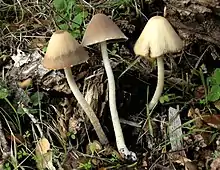Psathyrella longipes
Psathyrella longipes, the tall Psathyrella, is a species of agaric fungus in the family Psathyrellaceae and the brittlestem genus, Psathyrella. It was originally described as Hypholoma longipes by Charles Horton Peck in 1895;[2] Alexander H. Smith transferred it to Psathyrella in 1941.[3]
| Psathyrella longipes | |
|---|---|
 | |
| Scientific classification | |
| Domain: | Eukaryota |
| Kingdom: | Fungi |
| Division: | Basidiomycota |
| Class: | Agaricomycetes |
| Order: | Agaricales |
| Family: | Psathyrellaceae |
| Genus: | Psathyrella |
| Species: | P. longipes |
| Binomial name | |
| Psathyrella longipes | |
| Synonyms[1] | |
|
Hypholoma longipes Peck (1895) | |
As its name implies, the tall Psathyrella is unusual in its genus in having a relatively long stipe, 5-12cm long and 2-6mm thick.[4][5] Its cap is 2.5-4.5cm in diameter and conical, and has a "veil" of creamy-white fragments which contrast with its basic dull brown colour. The tall Psathyrella has an almost world-wide distribution: reports to iNaturalist show it as present in almost every country in Europe and North Africa, in most states and provinces of North America, in several South American countries, in East Asia and in Australia. It fruits in autumn and early winter.[4]
See also
References
- "Psathyrella longipes (Peck) A.H. Sm". MycoBank. International Mycological Association. Retrieved 2012-12-13.
- Peck CH. (1895). "New species of fungi". Bulletin of the Torrey Botanical Club. 22 (5): 198–211. doi:10.2307/2478162. JSTOR 2478162.
- Smith AH. (1941). "Studies of North American agarics—I". Contributions from the University of Michigan Herbarium. 5 (1): 1–73 (see p. 49).
- "California Fungi—Psathyrella longipes". Mykoweb: The fungi of California, Michael Wood & Fred Stevens. Retrieved 2021-12-17.
- Smith AH. (1972). (1957). "The North American species of Psathyrella" (PDF). Memoirs of the New York Botanical Garden. 24: 1–633.
External links
| Psathyrella longipes | |
|---|---|
| Gills on hymenium | |
| Cap is conical or campanulate | |
| Hymenium is adnate or seceding | |
| Spore print is brown to blackish-brown | |
| Edibility is unknown | |